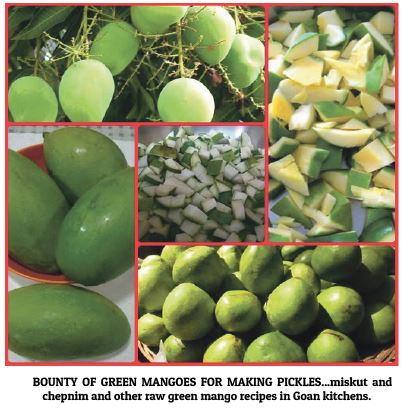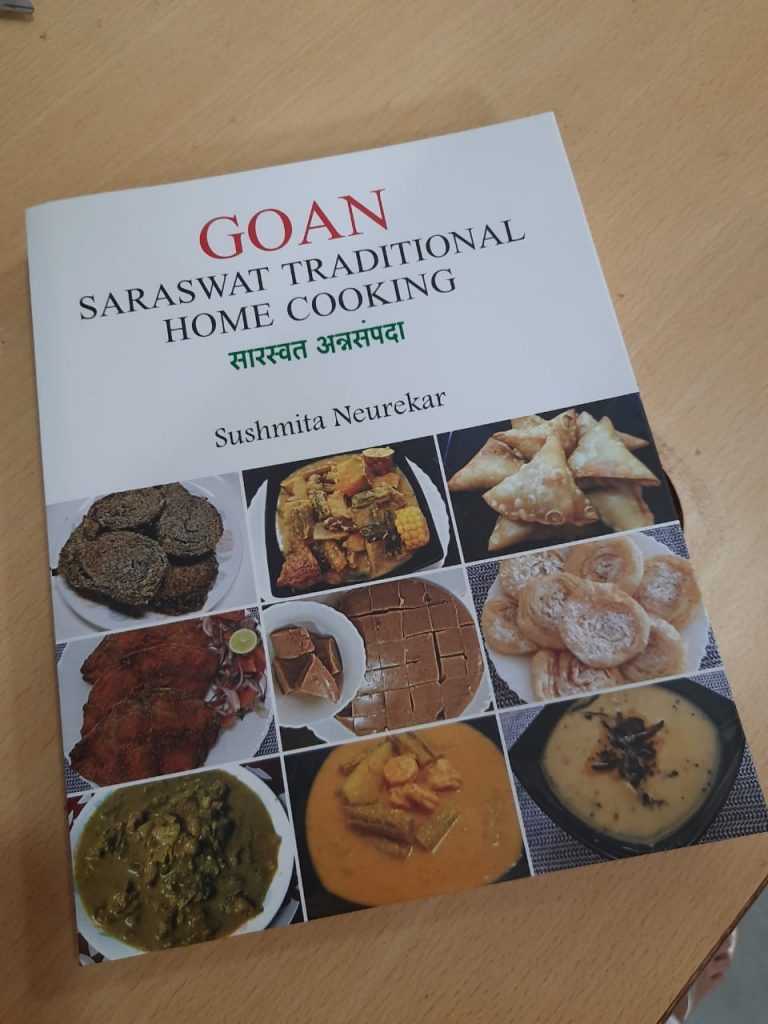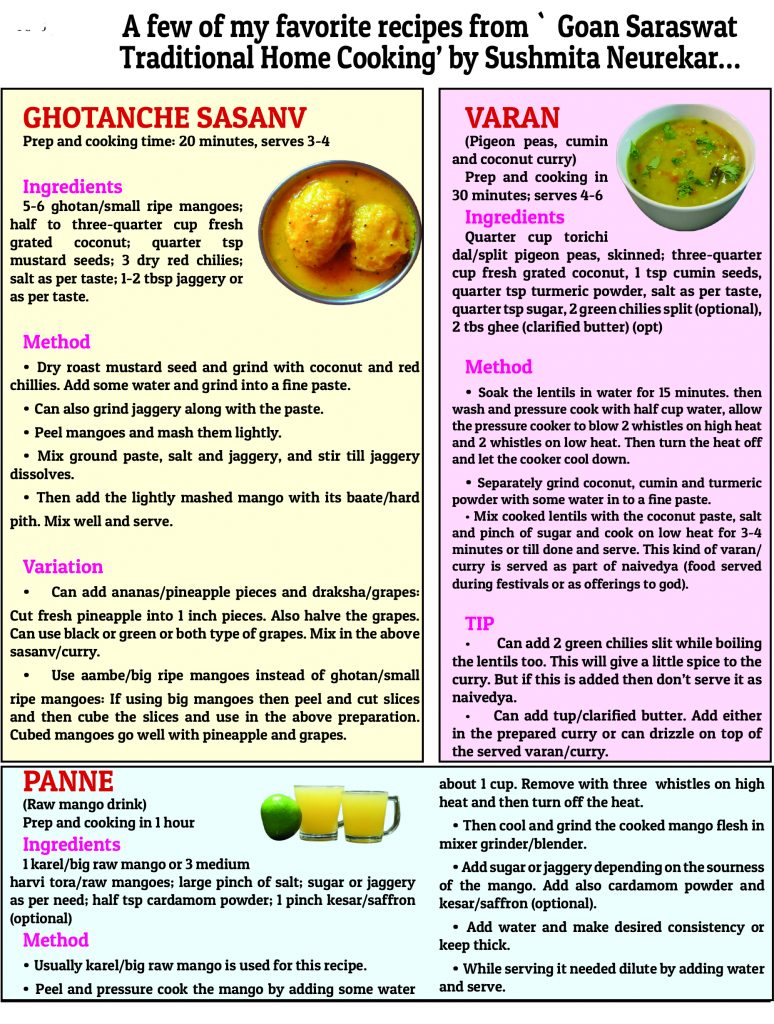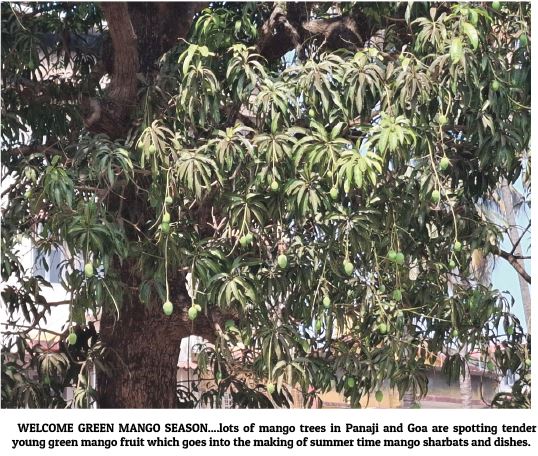By Tara Narayan
Fresh tart raw green mango sours are the flavor of the month of a very hot sweltering April…
A LITTLE bit of chopped or cubed or finely grated fresh raw green mango can make many routine dishes come alive with the palate aching for more of the same…think fresh raw green mango! This is the season for green mangoes and they’re everywhere in the wet markets of Goa, small round ones, big round ones, the long totapuri which offers a tart sweetness and vendors like to slice and serve smeared with sea salt-paprika…seasoned a little in brine water maybe for a day or two, yummylicious.
I’ve said it again and will say it again that Goa’s salt water whole mangoes called chepnim when sliced and served can take the place of olives wherever you wish. The whole mangoes are wiped and layered in salt in a large traditional container, covered with heavy stones to weigh the mangoes down…they ferment and soon the salty juices ooze out and turn the mangoes into a delight for the soul in a cheesy sandwich or as a side dish with the popular summer beverage of caju niro or better still hurrack…niro turns in time to hurrack and hurrack in time to feni, I like the first two versions most although the second is a spirited.
These days when I go out buying some chaat number I wonder why nobody thinks of adding some fine chopped green mango in the final green coriander garnish sprinkling! A bit of raw green or half ripe mango can make the palate ache for the tart flavors of life in the summer time…like aforesaid.

If you cruise around capital city Panjim where there a host of mango trees loaded with small and big green mango bounty, you will see our feathered friends having a feast and half relished mangoes will fall by kerbsides of several streets, sometimes it’s the wind which sends the odd mangoes falling and if you’re in the vicinity to see this phenomenon you will quickly go pick up the mango and tuck it into your bag, I do it. If it’s going to go to waste I may as well pick it up and check the mango out for fiber, flavor and what I may do with it to enjoy an exquisite kachi kairi flavor in my chutney or relish or the much-loved thecha Maharashtrian-style – just rough grind coconut, green chilli, green mangoes, cumin seeds, groundnuts till you get a heady relish to mash into your hot ghee-laced rice and tuck in. Thecha goes equally well with all kinds of roti of millets. Some homes add the blob of mango thecha to seasoned and tempered buttermilk with thickened with gram flour (besan)…so one arrives at a favorful light curry to pour atop toop-laced rice for lunch.
THIS is to say it is the season to think green mango, although early seemingly ripe mankurad (Goa’s favorite aristocratic mango) are already to be seen at the early morning pavement markets selling at Rs2,000 dozen, anyone? Not me, first of all if the mangoes have been force-ripened with calcium carbide or ethylene gas they’ll be quite yucky within and you’ll be chuck them out anyway…but by all means go for the green raw mangoes to make fresh mango miskut, fresh mango chunda, fresh mango thecha and beverages of aam ka panna, or some mango sherbet or mango kodi or light mango green rasam…serve to sip and be happy!
Mango tart or sour is a seasonal flavor to live for and folk will do many things with green mangoes like turning them into whole salted enticing masala)…amongst the pickle mangoes are ladwa or rajapuri variety out in the Mumbai wet markets and here the vendors are organized to not only wash, dry, cut or grate the mangoes you buy so that you may just take them home and steep them in masala or set them out in the sun for semi-drying before mixing in the masala and cooking in the sun (like the Gujarati favorite pickle choonda). One may sun cook or gas cook mango pickles.
I always offer this mango relish recipe when green mango season comes around: Simply wash, dry, skin and grate a tart green mango; also grate one or two medium size onion; squeeze out excess juice if you wish…add sea salt to taste, teaspoon of roasted cumin seed powder, teaspoon of paprika chili and grated jaggery as desired. Mix all and a most juicy tangy relish is ready to eat atop toast or tucked away in a phulka…enjoy all the vitamin C of green mango. Remember vitamin C is the fast healing vitamin and we need lots of it to keep our cellular system refreshed, daily think vitamin C in the form of a lemon juice or green salad. It’s one of the ACE vitamins recommended – A, C and E; eat a carrot, eat a tomato, eat an avocado and a handful of soaked, peeled almonds (the skins have tannin to irritate the throat).
ON to something else…..

THE only pure cuisine of Goa I feel is the cuisine of the Saraswat community and I also like it most because they have a glorious vegetarian spread too…and I’m mostly a vegetarian or vegan although in between I look for eggs or fish made the way I like it and that’s Saraswat style or Goan Portuguese caldin style only! If I were cooking properly at home I’d cook the Saraswat way only…and have over the years piled up on Gaud Saraswat Brahmin cookbooks of which there are many now.
My latest acquisition after much agonizing about should I or should I not is Sushmita Neurekar’s “Goan Saraswat Traditional Home Cooking” (I got it at a discounted rate of Rs1100) and it is quite chok-a-blok with recipes. Sushmita Neurekar says this is her personal collection of authentic recipes gathered over the last 35 years and it is by way of a tribute to her homeland with its “extraordinary food culture.”
Thank the God of good food that this is not one of your glossy hardcover coffee tabler of a cookbook, but an honest to goodness simple affair of a cookbook or rather a veritable compendium of recipes to amaze and educate one about the rich cuisine of this Saraswat community kitchen …it’s a breathtaking cookbook vis-à-vis an offering of all categories of meals, snacks, chutneys, pickles; breakfast fare from “sakalchi khaana” to “fodi, daangar, bhajji” (fried vegetables, cutlets and fritters); various “sukyo bhajyo” veg stir fries … “usalyo” (pulses and vegetable stir fries), “pale bhajyo” (leafy veggies), “patal bhajyo” (veg curries), the much loved “dal, ross and kadi “ section (think “daliche toi, nallachya rosache, varan,” etc, one of my favorite sections) and so much, much more. There is the “godshe” or sweet dishes section, and “vismrutitli jevna” or forgotten recipes section, also a section dedicated to “purumet” or monsoon time preserved food…fascinating how many ways one may make say the tongue-touchers of “kismur” or digestive kokum liquors to round off a happy meal!
Not to forget the tantalizing repertoire of sea food and meat-based recipes from “nustyache suke” to “nustyachi humana” and “tondaka”… “ande, chicken,mutton, pulav, khichdi” all kinds of rice dishes. If you’re interested in learning how to do the best of wholesome niche Goan vegetarian and non-vegetarian food of the Saraswat home – here’s your book! Sushmita Neurekar’s “Goan Saraswat Traditional Home Cooking.” I think I will give away all my other cookbooks of Saraswat cuisine and just hang on to this one just newly acquired if only to make such recipes after my own heart such as “pachadi – lentil, raw mango and coconut chutney” and “bukni hingachi” (dry coconut and asafetida chutney)…and all the other “chutnyo, karam, sasav, bhart, kismur, raite, koshimbir.” Wow, here are recipes to live and die for as I always say and here you’ll be looking up local Konkan veggies, ingredients, you may never have seen or heard of before, this cuisine is a real adventure to explore if you’re asking me. Thank you my dear Sushmita Neurekar, I feel like going back to cooking again!

